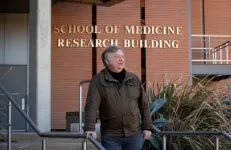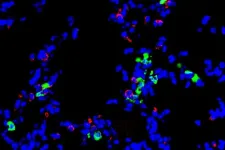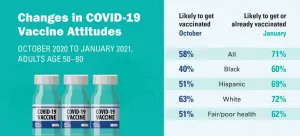(Press-News.org) COLUMBUS, Ohio - A new SARS-CoV-2 vaccine candidate, developed by giving a key protein's gene a ride into the body while encased in a measles vaccine, has been shown to produce a strong immune response and prevent SARS-CoV-2 infection and lung disease in multiple animal studies.
Scientists attribute the vaccine candidate's effectiveness to strategic production of the antigen to stimulate immunity: using a specific snippet of the coronavirus spike protein gene, and inserting it into a sweet spot in the measles vaccine genome to boost activation, or expression, of the gene that makes the protein.
Even with several vaccines already on the market, researchers say this candidate may have advantages worth exploring - especially related to the measles vaccine's established safety, durability and high-efficacy profile.
"The measles vaccine has been used in children since the 1960s, and has a long history of safety for children and adults," said Jianrong Li, senior author of the study and a professor of virology in The Ohio State University Department of Veterinary Biosciences.
"We also know the measles vaccine can produce long-term protection. The hope is that with the antigen inside, it can produce long-term protection against SARS-CoV-2. That would be a big advantage, because right now we don't know how long protection will last with any vaccine platforms."
The Ohio State Innovation Foundation has exclusively licensed the technology to Biological E. Limited (BE), a Hyderabad, India-based vaccine & pharmaceutical company.
The research is published online today (March 9, 2021) in the journal Proceedings of the National Academy of Sciences.
The coronavirus that causes COVID-19 uses the spike protein on its surface to bind to its target cells in the nose and lungs, where it makes copies of itself and releases them to infect other cells. Like all vaccines, this candidate initiates the production of antibodies that recognize the new protein as foreign, training the immune system to attack and neutralize the spike protein if SARS-CoV-2 ever enters the body.
Li created the COVID-19 vaccine using a live attenuated measles virus as a vehicle with colleagues Mijia Lu, a postdoctoral researcher in Li's laboratory and first author on the paper, and co-authors Stefan Niewiesk, Ohio State professor of veterinary biosciences, and Mark Peeples, professor of pediatrics at Ohio State and a researcher at Nationwide Children's Hospital in Columbus.
For this work, the researchers tested seven versions of the spike protein to find the most effective antigen. They landed on a stabilized "prefusion" version of the protein - the shape the protein is in before it infects a cell.
The scientists inserted the prefusion spike protein gene containing manufacturing instructions into a segment of the measles vaccine genome to generate high expression of the protein, reasoning that the more SARS-CoV-2 spike protein produced, the better the immune response.
The team tested the vaccine candidate in several animal models to gauge its effectiveness, and found that the vaccine induced high levels of neutralizing antibodies against SARS-CoV-2 in all of the animals.
Some may think most humans' immunity to measles, thanks to decades of widespread vaccination, would render its status as a coronavirus vaccine vehicle useless. To quell those concerns, researchers gave cotton rats a measles vaccine and showed that a second immunization with the measles-based SARS-CoV-2 vaccine candidate could induce a strong neutralizing antibody response to the coronavirus.
Genetically modified mice produced helper T cells - a type of white blood cell - in response to the vaccine, another important way the body fights infection, and severe disease in particular.
"The orientation of T helper cells induced by a vaccine is an important predictor of protection, and this vaccine mainly induces Th1 cells, which enhances the safety and efficacy of the vaccine," said co-author Amit Kapoor, associate professor of pediatrics at Ohio State and a researcher at Nationwide Children's Hospital.
Golden Syrian hamsters, which are susceptible to contracting COVID-19, received the vaccine and were then injected with the coronavirus. The vaccinated hamsters were protected from lung infection and other sickness symptoms indicated through weight loss.
"When we looked at the amount of neutralizing antibody induced in the hamster, it was actually higher than from people who had been infected with COVID, suggesting the vaccine may be better than SARS-CoV-2 infection in inducing protective immunity. That was our goal," Peeples said.
The researchers have confidence in the platform not only because the measles vaccine is safe, effective and affordable to produce, but because several experimental measles-based vaccines against other viruses are in development. A vaccine against chikungunya virus, spread by mosquitos, has been shown to be safe, well-tolerated and good at provoking an immune response in a Phase 2 clinical trial.
And even with a variety of COVID-19 vaccines now available in the United States and other countries, there is still a lot to learn about which are the safest and most effective for specific populations, such as children and pregnant women, and which vaccines are the most economical to produce.
"We can make vaccines much more quickly now than in the past. But if we had to do it the traditional way this time, we wouldn't have a vaccine protecting us in this short amount of time," Niewiesk said. "The mRNA vaccines in use now were made in record time. And they protect against disease and are safe. Although not quite as fast, we were able to make this vaccine much more quickly than the original measles vaccine.
"We don't yet know how long the mRNA vaccines will protect or how much they will cost. In the meantime, an alternative vaccine that should protect for a long time, is easy to manufacture and cheap seems like a good idea."
INFORMATION:
This study was supported by startup funds and bridge funds from Ohio State's Department of Veterinary Biosciences and College of Veterinary Medicine, a seed grant from Nationwide Children's Hospital and grants from the National Institutes of Health.
Additional co-authors are Yuexiu Zhang, Anzhong Li, Olivia Harder, Cong Zeng, Xueya Liang, Shan-Lu Liu and Prosper Boyaka of Ohio State's Department of Veterinary Biosciences; Piyush Dravid, Sheetal Trivedi, Mahesh KC, Supranee Chaiwatpongsakorn, Masako Shimamura, Asuncion Mejias and Octavio Ramilo of the Research Institute at Nationwide Children's Hospital; and Ashley Zani, Adam Kenney, Chuanxi Cai and Jacob Yount of the Department of Microbial Infection and Immunity in Ohio State's College of Medicine.
Contact:
Jianrong Li,
Li.926@osu.edu
Written by Emily Caldwell,
Caldwell.151@osu.edu
Delaying second doses of COVID-19 vaccines should reduce case numbers in the near term. But the longer-term case burden and the potential for evolution of viral "escape" from immunity will depend on the robustness of immune responses generated by natural infections and one or two vaccine doses, according to a Princeton University and McGill University study published March 9 in the journal Science.
"Several countries including the United Kingdom and Canada have stated that they will delay second doses of COVID-19 vaccines in response to supply shortages, but also in an attempt to rapidly increase the number of people immunized," said lead author Chadi Saad-Roy, a Ph.D. candidate in Princeton's Lewis-Sigler Institute for Integrative ...
Members of the COVID-19 Primary Care Database Consortium explain how the use of big data containing millions of primary care medical records provides an opportunity for rapid research to help inform patient care and policy decisions during the COVID-19 pandemic. Established in April 2020, the Consortium brings together experts in big data, epidemiology, intensive care, primary care and statistics, as well as journal editors, patient and public representatives, and front-line clinical staff from the universities of Oxford, Cambridge, Southampton, Bristol and Nottingham
The consensus statement that the consortium has developed and described in the article aims to facilitate transparency and rigor in methodological approaches, as well as consistency in defining and reporting ...
Members of the Perelman School of Medicine at the University of Pennsylvania and its health system developed and implemented a new model of collaborative care called The Penn Integrated Care (PIC) program. PIC includes a resource center to support intake, triage and referral management and collaborative care services in primary care practices. PIC was created to increase access to and engagement with mental health professionals to improve mental and physical health outcomes. Primary care physicians were able to refer patients with any mental health symptom or condition to PIC. In 12 months, 6,124 unique patients were referred from eight primary care clinics to either the PIC Resource Center or were connected with a mental health professional. ...
RIVERSIDE, Calif. -- Variants of the coronavirus are appearing in different parts of the world, many of them spreading with alarming speed. One contagious variant is the South African, or SA, variant, identified by an international team of researchers, including biomedical scientists from the University of California, Riverside.
"The new COVID-19 variants are the next new frontier," said Adam Godzik, a professor of biomedical sciences in the UC Riverside School of Medicine and a member of the research team that made the discovery. "Of these, the ...
Scientists at Washington University School of Medicine in St. Louis have implicated a type of immune cell in the development of chronic lung disease that sometimes is triggered following a respiratory viral infection. The evidence suggests that activation of this immune cell -- a type of guardian cell called a dendritic cell -- serves as an early switch that, when activated, sets in motion a chain of events that drives progressive lung diseases, including asthma and chronic obstructive pulmonary disease (COPD).
The new study, published in The Journal of Immunology, opens the door to potential preventive ...
New study finds the skyrocketing cost of drugs in U.S. used to treat hookworm and other soil-transmitted parasites increases patient costs, suggests decreased quality of care
A new study finds that the increasingly high prices in the United States of the drugs used to treat three soil-transmitted helminth infections--hookworm, roundworm (ascariasis), and whipworm (trichuriasis)--is not only the major driver for the increase in costs to patients with either Medicaid or private insurance, but it also may have a damaging impact on the quality-of-care patients receive as clinicians shift their prescribing patterns to more affordable yet less-effective medicines covered ...
https://doi.org/10.15212/bioi-2021-0002
Announcing a new article publication for BIO Integration journal. In this article the authors Jingdun Xie, Zhenhua Qi, Xiaolin Luo, Fang Yan, Wei Xing, Weian Zeng, Dongtai Chen and Qiang Li; from Sun Yat-sen University, Guangzhou, Guangdong, China discuss integration analysis of m6A regulators and m6A-related genes in hepatocellular carcinoma (HCC).
N6-Methyladenosine (m6A) RNA methylation of eukaryotic mRNA is involved in the progression of various tumors. This study comprehensively analyzed m6A regulators and m6A-related genes through an integrated bioinformatic analysis, ...
Last fall, nearly half of older adults were on the fence about COVID-19 vaccination - or at least taking a wait-and-see attitude, according to a University of Michigan poll taken at the time.
But a new follow-up poll shows that 71% of people in their 50s, 60s and 70s are now ready to get vaccinated against COVID-19 when a dose becomes available to them, or had already gotten vaccinated by the time they were polled in late January. That's up from 58% in October.
Three groups of older adults with especially high risk of severe COVID-19 -- Blacks, Hispanics and people in fair or poor health - had even bigger jumps in vaccine receptiveness between October and late January.
The poll shows a 20-point jump in just ...
BOSTON - Almost immediately after the first mRNA-based COVID-19 vaccines were authorized for emergency use and were administered to individuals outside of clinical trials, reports of anaphylaxis--a life-threatening whole-body allergic reaction--raised widespread concerns among experts and the public. Now, real world data on vaccinations among employees at Mass General Brigham provide reassurances of the rarity of such serious reactions, and the ability to recover from them. The findings are published in the END ...
Past studies on whether incarcerated people with mental illness are more likely to be placed in solitary confinement have yielded mixed results. A new study examined the issue in one state's prisons, taking into account factors related to incarcerated men and the facilities where they were imprisoned. It found that having a mental illness was associated with a significant increase in the likelihood of being placed in extended solitary confinement.
The study, by researchers at Florida State University (FSU), appears in Justice Quarterly, a publication of the Academy of Criminal Justice Sciences.
"Our findings provide new information on how mental illness shapes experiences for incarcerated men, and more broadly, on how the criminal justice ...


